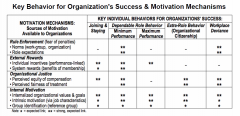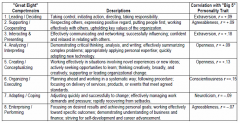![]()
![]()
![]()
Use LEFT and RIGHT arrow keys to navigate between flashcards;
Use UP and DOWN arrow keys to flip the card;
H to show hint;
A reads text to speech;
39 Cards in this Set
- Front
- Back
|
Employee engagement* |
Individual experience of work combining: •vigor (high energy) •dedication (significance, pleasure, enthusiasm, challenge) •absorption (sustained concentration, being happily engrossed) e.g. Servers at a Greekrestaurant reported greater engagement on days when their manager personally challenged, coached, and complimented them.(Engagement includes elements of job satisfaction, job involvement, intrinsic motivation and arousal; varies from time to time;and in meta-analyses correlated with performance and organizational citizenship behavior, and inversely with burnout.) |
|
|
job involvement |
Individual's psychological or self-identification with his or her work e.g.: nurse so personally invested in her profession that he/she continues as a volunteer after retiring |
|
|
Job satisfaction* |
1) Individual's subjective evaluation of his or her work role overall e.g.: John is completely satisfiedwith his job as a teacher and would not leave it for another job. 2) Pleasure an individual derives from work e.g.: Jimobtains great, personal enjoyment and fulfillment from his work as a plastic surgeon. (A meta-analysis of research on jobsatisfaction and performance reported an average correlation of r = +.30.) |
|
|
correlates (correlation)** |
Observed relationship of two variables measured for the same individuals (or other units) in which values of the variable co-vary i.e.: an individual's value for one variable is more or less predictable from the value of the other e.g.: Measures of individual intelligence have consistently correlated with job performance |
|
|
Likert Scale |
Multi-item questionnaire intended to measure 1 variable via a series of statements, asking for agreement or disagreement from 5 to 7 choices (agree, slight agree, etc.) w/ responses combined into an index e.g.: 10-item job-satisfaction scale of statements like, "I am satisfied with mysupervisor," with instructions to indicate agreement from 5 choices, scored by adding 10 responses. |
|
|
Organization Citizenship Behavior |
Individual action, beyond role-expectations, to benefit the organization e.g.: AFedEx driver, stopped by a washed-out road, rented a helicopter with his credit card to take an over-night package to a hospital. |
|
|
Types of OCB |
1) altruism: helping others 2) conscientiousness: punctuality, orderliness, and rule-following 3) courtesy 4)sportsmanship: fair treatment of others and toleration of adverse conditions 5) civic virtue: responsible participation ingovernance. (Research has found this extra-role behavior positively correlated with job satisfaction.) |
|
|
Performance* |
Extent to which work processes, products, and/or services meet expectations of those who receive or review them e.g.: Ford transmission assembly team completed and tested their assigned week's quota of transmissions on timeand within managers' expectations for quality. (Recipients & reviewers of work can include managers, team-mates, customers,subordinates, regulators, contractors, and suppliers. Expectations about work output concern timing, quality, accuracy, amount,work processes, and other features.) |
|
|
"Big Five" traits** |
McCrae & Costa's (1987) taxonomy of 5 multi-faceted, composite personality traits to summarize dozensof traits studied earlier: Openness (to new experience) Conscientiousness Extraversion Agreeableness Neuroticism(or its opposites, Resilience or Emotional Stability) (Acronym, "OCEAN"). |
|
|
Cognitive ability |
Individual capacities to understand, reason, plan, visualize, apply knowledge & solve problems (component of intelligence) e.g.: On a cognitive ability test, Lyn scored average or higher on reading comprehension,logical reasoning, and numerical calculation, and below average on spatial visualization |
|
|
Competency |
Individual capability of correctly performing specific work procedures and/or accomplishing certain results e.g.: a) Piloting a Boeing 777 airliner; b) Establishing rapport with interviewees; c) Playing Bach's first violin sonata.(Competencies call for combinations of learned knowledge and skills, natural abilities and talent, and possibly other attributes. |
|
|
Core Self-Evaluation** |
Individual's personal appraisals of his/her overall worth and capability, consisting of self-esteem, generalized self-efficacy; internal locus of control, and emotional stability e.g.: George scored high on CSE, indicating ahigh opinion of himself and his calmness, influence over his life, and capacity to accomplish what he tries to do. See "Big Five"personality traits; composite variable; personality. |
|
|
Emotional intelligence |
Capacities for recognizing feelings in oneself and others, managing them effectively in relationships, and maintaining self-motivation e.g.: Administrative assistant recognizes boss's sour mood, puts offdelivering bad news until later when mood improves. Facets proposed by Goleman (1998): 1) Self-awareness of emotions inthe moment and of personal capabilities. 2) Self-regulation of emotions 3) Self-motivation to pursue goals and overcomefrustration 4) Empathy, or sensing others' feelings and developing rapport 5) Social skills, or reading interpersonal situationsand interacting smoothly and cooperatively to persuade, lead, negotiate, and settle disputes. |
|
|
Intelligence* |
Individual's general mental ability, or capacity for and speed of acquiring and applying knowledge and skill and adapting to environments. e.g.: Mark, an English-speaker, demonstrated intelligence by learning enough Spanish in afew minutes from a translation guide to order a meal in Madrid. |
|
|
Personality* |
Relatively enduring, individual habits and preferences that recur in many different circumstances e.g.: George has an extraverted personality, enjoys being with people, rarely spends time alone. |
|
|
Self-Efficacy* |
"Belief that one can achieve what one sets out to do" —(Bandura, 1997) e.g.: a) After graduating from UT,Ralph believes he can accomplish nearly any goal he sets for himself. Types: 1) Generalized self-efficacy (belief in personalcapacity to succeed, similar to optimism) 2) Task- or job-self-efficacy (confidence in personal capacity to do particular work). (A 2001 meta-analysis of 10 studies reported generalized self-efficacy correlated with job performance, r = +.19, andjob satisfaction, r = +.38. Self-efficacy is studied as both as a learned self-perception and as a personality trait.) |
|
|
Deci's (Intrinsic Motivation theory) |
Basic proposition: Contingent, tangible rewards or incentives (expected rewards) reduce intrinsic motivation (measured as free-choice behavior & self-reported interest in the task). |
|
|
Equity Theory |
Basic propositions: 1) Workers seek equity (fairness or parity) in comparison with peers, or equal ratios ofoutcomes (rewards, like pay) to inputs (contributions, like expertise or effort). 2) Perceived disparity leads to inequity(perceived injustice) and motivation to restore equity: a) Underpayment hypothesis: workers who see peers as having betterratios of rewards to contributions feel motivated to restore equity, for instance by complaining to the boss or doing less. b)Overpayment hypothesis: workers who see themselves as having better ratios of rewards to contributions than peers feeloverpaid, and motivated to restore equity, for example doing more. (Dozens of empirical studies support the underpaymenthypothesis. The overpayment hypothesis has practically no support.) |
|
|
Expectancy theory |
Selected propositions: 1) Motivation depends on "expectancy" (subjectiveprobability) that effort produces the individual's target performance level, and its overall desirability. 2) Desirability ("valence,"from positive to negative) of a target performance level depends on its "instrumentality" (subjective connection, positive ornegative) to the individual's specific, personal (subjective) outcomes, and their valences, positive or negative. 3) Outcomes withboth negative valence and negative instrumentality add positive motivation to a level of performance. Example: Salesperson Joefeels motivated to meet the month's minimum quota (lowest acceptable performance level) to avoid getting fired (negativeinstrumentality of below-quota performance for the negative outcome, getting fired.) Research support: Mixed. Dozens ofstudies support the predicted correlation of subjective instrumentality X desirability of outcomes with valence (subjectivedesirability) of performance level ("valence model"), but valence has not consistently predicted subsequent performance. |
|
|
Extra-role behavior* |
Individual's actions, beyond job-duties or role-expectations, to benefit his/her organization e.g.: During a power failure from an ice storm at a chemical plant, a maintenance crew worked through Christmas break to keep thepiping network from freezing and slept in the boiler-room. |
|
|
Goal setting theory |
Basic propositions: 1) Having a specific, difficult goal leads to better performance than a "do yourbest" goal or no goal. 2) Specific, difficult goals aid performance by directing attention, energizing effort, encouragingpersistence, and motivating "task strategies" like planning and learning. Research support: consistent, in dozens of studies. |
|
|
Intrinsic (internal) motivation* |
Desire to engage in an activity because it is inherently satisfying or personally fulfilling, independent of extrinsic rewards •internalized organizational values & goals •intrinsic motivation (via job characteristics) •group identification (reference group) e.g.: Emergency Room doctor finds her work so satisfying and motivating thatshe volunteers some days off at another Emergency Room. |
|
|
Maslow's need hierarchy theory |
Basic proposition: People have 5 motivation-related needs, in a hierarchy, from "basic"to "higher-order": physiological, safety, social (acceptance, love), ego (mastery, recognition) & self-actualization. Hypotheses: 1) Satisfaction / progression: When needs are met at one level, an individual is motivated by the next higher-order, unmetneed. Example: If physiological & safety needs are met, social needs motivate.). 2) Dissatisfaction / regression: Un-met needstake precedence over higher-order needs. e.g.: Threat to personal safety needs take precedence over ego-needs.) Researchsupport: besides anecdotes, practically nonexistent; some say the theory has never been adequately tested. |
|
|
Motivation* |
Conditions that energize, direct, or maintain behavior e.g.: a) A stock broker works 80 hours per week toearn lucrative commissions and bonuses. b) An employee angry about an "unfair" evaluation got a gun and shot his supervisor. |
|
|
Organizational justice |
•Perceived fairness in relationships in an organization •Perceived equity of compensation e.g.: Retail salesperson perceives thepay as fair, considering experience, performance, and peers' pay. |
|
|
Types of organizational justice** |
1) Distributive justice (perceived fairness inallocation of rewards or valued outcomes; refers to equity) 2) Procedural justice (perceived fairness and impartiality ofprocedures used to determine the outcomes workers receive) 3) Interpersonal justice (perceived fairness of treatment byothers, especially those in authority) 4) Informational justice (perceived fairness of information used in making decisionswith personal impact). |
|
|
system rewards |
tbd |
|
|
Reinforcement theory |
Selected propositions: 1) Specific, individual behavior followed by a reward (reinforcement, like $or praise), becomes more likely to recur in the presence of an associated cue. 2) Behavior persists longer after intermittent(occasional, unpredictable) than regular reinforcement. Application: Performance-based pay. |
|
|
Key Behavior for Organization's Success & Motivation Mechanisms |

|
|
|
Assessment |
Planned evaluation or appraisal e.g.: Structed interview for evaluating applicants for the job of chemical plant worker |
|
|
Psychological test |
Measurement of a targeted sample of individual behavior, via questionnaire, work sample, or other method e.g.: NEO-PI, copyrighted, written assessment of the "Big Five" personality traits |
|
|
"Great Eight" Workplace Competencies |

Broad categories of workplace competency applicable across work roles and specialties, from factor analysis of 112 specific competencies |
|
|
attitude |
Individual, subjective evaluation (pos, neg, or neutral) of an identifiable entity or object |
|
|
Critical incident technique |
Asking in an interview or questionnaire for descriptions of specific events that illustrate key moments for both successful and inadequate job performance or job satisfaction & dissatisfaction |
|
|
turnover |
rate at which employees of an organization leave their jobs, as a percentage of the workforce lost (and replaced) per yhear |
|
|
Halo effect |
In evaluating multiple dimensions or facts, a tendency to assign concsistently high or low ratings across dimensions, even those not directly experienced |
|
|
meta-analysis |
statistical summary of accumulated scientific knowledge on a specific hypothesis from multiple, published studies that tested it |
|
|
job enrichment |
re-design of individual work to include features that foster intrinsic motivation, such as added responsibility, variety, or autonomy e.g.: In an automobile assembly plant, re-designing jobs intransmission assembly from installing one part to assembling whole sub-assemblies. |
|
|
workplace deviance |
counter-normative behavior (rule-breaking) e.g.: sabotage, theft, violence |

